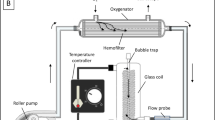Abstract
Purpose
Microdialysis allows the biochemical analysis of interstitial fluids of nearly every organ as a bedside procedure. This technique could be useful to reveal data about the myocardial metabolism during cardiopulmonary bypass in human coronary artery bypass graft (CABG) surgery.
Methods
In 17 patients undergoing CABG a myocardial microdialysis catheter (CMA 70, CMA/Microdialysis AB, Sweden) was inserted in the apical region of the beating heart. Microdialysis measurements were performed at timed intervals before, during, and after cardiopulmonary bypass (CPB). The concentrations of lactate and pyruvate were analyzed semi-continuously.
Results
During CPB the myocardial lactate- pyruvate- ratio (LPR) rose from an initial 11 (8–15) to 33 (29–41) (P<0.01). After CPB the LPR decreased to 4 (3–7) at the end of observation (P<0.05). The pyruvate concentration showed an immediate increase from 34 (30–42) µM at the end of CPB to 181 (147–234) µM after removal of the cross-clamp with subsequent increase during reperfusion (P<0.01). Plasma lactate and pyruvate showed no essential changes during the study.
Conclusion
Using the microdialysis technique it was possible to analyze myocardial metabolic changes during CABG. The course of myocardial LPR as a sensitive indicator of the myocardial redox state showed profound changes during and after CPB. We propose the microdialysis technique as an additional monitoring tool in CABG.



Similar content being viewed by others
References
Opie LH, Mansford KR (1971) The value of lactate and pyruvate measurements in the assessment of the redox state of free nicotinamide-adenine dinucleotide in the cytoplasm of perfused rat heart. Eur J Clin Invest 1:295–306
Hultman J, Ronquist G, Hansson HE, Aberg T, Bertrand-Guy M (1986) Myocardial energy metabolism during mitral valve replacement. Thorac Cardiovasc Surg 34:351–355
Lewandowski ED, Damico LA, White LT, Yu X (1995) Cardiac responses to induced lactate oxidation: NMR analysis of metabolic equilibria. Am J Physiol 269:160–168
Ungerstedt U (1991) Microdialysis: principles for studies in animals and man. J Intern Med 230:365–373
Bolinder J, Hagström E, Ungerstedt U, Arner P (1989) Microdialysis of subcutaneous adipose tissue in vivo for continuous glucose monitoring in man. Scand J Clin Lab Invest 49:465–474
Langemann H, Habicht J, Mendelowitsch A, Kanner A, Alessandri B, Landolt H, Gratzl O (1996) Microdialytic monitoring during a cardiovascular operation. Acta Neurochir Suppl 67:70–74
Habicht JM, Wolff T, Langemann H, Stulz P (1998) Intraoperative and postoperative microdialysis measurement of the human heart: feasibility and initial results. Swiss Surg 2:26–30
Kennergren C, Mantovani V, Lönnroth P, Nyström B, Berglin E, Hamberger A (1999) Monitoring of extracellular aspartate aminotransferase and troponin t by microdialysis during and after cardioplegic heart arrest. Cardiology 92:162–170
Kennergren C, Mantovani V, Strindberg L, Berglin E, Hamberger A, Lonnroth P (2002) Myocardial interstitial glucose and lactate before, during and after cardioplegic heart arrest. Am J Physiol Endocrinol Metab 284:88–94
Suistomaa M, Ruokonen E, Kari A, Takala J (2000) Time-pattern of lactate and lactate to pyruvate ratio in the first 24 hours of intensive care emergency admissions. Shock 14:8–12
Valenti D, de Bari L, Atlante A, Passarella S (2002) L-Lactate transport into rat heart mitochondria and reconstruction of the L-lactate/pyruvate shuttle. Biochem J 15:101–104
Parolin ML, Spriet L, Hultman E, Matsos MP, Hollidge-Horvat MG, Jones ML, Heigenhauser G (2000) Effects of PDH activation by dichloroacetate in human skeletal muscle during exercise in hypoxia. Am J Physiol Endocrinol Metab 279:752–761
Buckberg GD (2001) Cardioplegia solutions: unproven herbal approach versus tested scientific study. Semin Thorac Cardiovasc Surg 13:52–55
Kato NS, Buckberg GD (1992) New intraoperative cardioprotective strategies for myocardial protection. Curr Opin Cardiol 7:959–967
Ungerstedt U (1991) Microdialysis: principles for studies in animals and man. J Intern Med. 230:365–373
Ungerstedt U (1997) Microdialysis: a new technique for monitoring local tissue events in the clinic. Acta Anaesthesiol Scand Suppl 110:123
Franco-Cereceda A, Owall A, Settergren G, Sollevi A, Lundberg JM (1990) Release of neuropeptide Y and noradrenaline from the human heart after aortic occlusion during coronary artery surgery. Cardiovasc Res 24:242–246
Zemgulis V, Ronquist G, Bjerner T, Henze A, Waldenstrom A, Thelin S, Wikstrom G (2001) Energy-related metabolites during and after induced myocardial infarction with special emphasis on the reperfusion injury after extracorporeal circulation. Acta Physiol Scand 171:129–143
Schoder H, Knight RJ, Kofoed KF, Schelbert HR, Buxton DB (1998) Regulation of pyruvate dehydrogenase activity and glucose metabolism in post-ischaemic myocardium. Biochim Biophys Acta 27:62–72
Bunger R, Swindall B, Brodie D, Zdunek D, Stiegler H, Walter G (1993) Pyruvate attenuation of hypoxia damage in isolated working guinea-pig heart. Int J Biochem 25:725–729
Parolin, ML, Spriet LL, Hultman E, Hollidge-Horvat MG, Jones NL, and Heigenhauser GJF (2000) Regulation of glycogen phosphorylase and PDH during exercise in human skeletal muscle during hypoxia. Am J Physiol Endocrinol Metab 278:522–534
Lewandowski E, White L (1995) Pyruvate dehydrogenase influences postischemic heart function Circulation 91:2071–2079
Kobayashy K and Neely JR (1983) Effects of ischemia and reperfusion on pyruvate dehydrogenase activity in isolated rat hearts. J Mol Cell Cardiol 15:359–367
Kline JA, Thornton LR, Lopaschuck GD, Barbee RW, Watts JA (2000) Lactate improves cardiac efficiency after hemorrhagic shock. Shock 14:215–221
Gore DC, Jahoor F, Hibbert JM, De Maria EJ (1996) Lactic acidosis during sepsis is related to increased pyruvate production, not deficits in tissue oxygen availability. Ann Surg 224:97–110
Khabbaz KR, Zankoul F, Warner KG (2001) Intraoperative metabolic monitoring of the heart: online measurement of myocardial tissue pH. Ann Thorac Surg 72:2227–2233
Author information
Authors and Affiliations
Corresponding author
Rights and permissions
About this article
Cite this article
Bahlmann, L., Misfeld, M., Klaus, S. et al. Myocardial redox state during coronary artery bypass grafting assessed with microdialysis. Intensive Care Med 30, 889–894 (2004). https://doi.org/10.1007/s00134-004-2199-3
Received:
Accepted:
Published:
Issue Date:
DOI: https://doi.org/10.1007/s00134-004-2199-3




